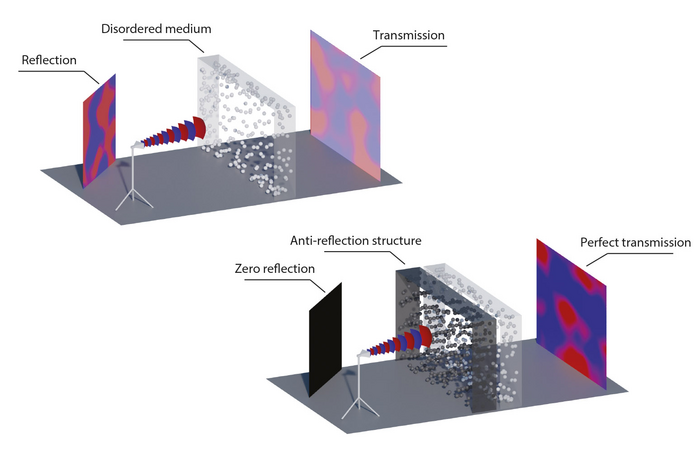A bad wireless reception, the noise in the radio signal or poor visibility in the fog – all these annoyances have to do with the fact that waves such as visible light or microwave signals are deflected and reflected by numerous disordered obstacles. TU Wien in Vienna (Austria) and the University of Rennes (France) have now jointly developed a surprising method to eliminate wave reflections altogether.

Credit: TU Wien
A bad wireless reception, the noise in the radio signal or poor visibility in the fog – all these annoyances have to do with the fact that waves such as visible light or microwave signals are deflected and reflected by numerous disordered obstacles. TU Wien in Vienna (Austria) and the University of Rennes (France) have now jointly developed a surprising method to eliminate wave reflections altogether.
The method allows the calculation of a tailor-made anti-reflective structure. It can be used, for example, to design an additional layer to a wall that is only partially permeable to a wireless signal so that the entire signal can be channeled through the wall without reflections.
Until now, it was not even clear on a theoretical level that such a thing was possible at all – now the research team was able to present a calculation method for this and also tested it successfully in an experiment: microwaves were sent through a complex, disorderly maze of obstacles, then the matching anti-reflective structure was calculated and placed in front of the obstacles in the experiment – the reflection could be made to disappear almost completely: none of the waves returned to the side from which they were injected.
An anti-reflective coating for almost everything
“You can think of it as being similar to the anti-reflective coating on your pair of glasses,” says Prof. Stefan Rotter from the Institute of Theoretical Physics at TU Wien. “You add an extra layer to the surface of the glasses, which then causes light waves to pass better to your eyes than before – the reflection is reduced.”
With conventional glasses this is still relatively simple and meanwhile standard technology. It is much more difficult when dealing with a disordered medium in which a wave is repeatedly scattered and deflected until it finds its way out of such a maze via complicated paths. A cloudy pane of glass or a piece of sugar falls into this category – or even a concrete wall onto which a radio signal impinges. The waves are scattered at many points so that only a part of them gets through, the rest is reflected or absorbed in the wall.
But as it now turns out, even with complex wave scattering, it is possible to find a “coating” that prevents any reflection. “First, you simply have to send certain waves through the medium and measure exactly in which way these waves are reflected by the material,” explains Michael Horodynski (TU Wien), the first author of the current publication. “We were able to show that this information can be used to calculate a corresponding compensating structure for any medium that scatters waves in a complex way, so that the combination of both media allows waves to pass through completely. The key to this is a mathematical method that we developed to calculate the exact shape of this anti-reflective layer.”
Experiments with microwaves
In the experimental implementation of this new method carried out in Rennes, microwaves were first sent through a metallic waveguide in which the waves are scattered by dozens of small objects made of metal and Teflon placed completely randomly and in a disorderly manner. Only about half of the microwave radiation reaches the other side, the rest is reflected.
After precisely measuring the scattering behaviour of this system, it was possible to use the newly developed method to calculate which additional scattering points form a perfect “anti-reflective layer” for exactly this random system.
And indeed: if waves are first sent through the anti-reflective region with the mathematically optimised additional scattering points and then travel from there through the region with the randomly arranged scatterers, they end up one hundred percent on the other side – no wave returns to the starting point and the reflection is negligible; and this is true for any waveform that hits the anti-reflective structure.
From wireless signals to the microscope
The fact that it is possible to compensate for wave scattering with additional scattering opens up possibilities in very different areas: the technology could be useful not only for better wireless reception, but also for imaging techniques, for example in biophysics. Wave dynamics and wave scattering will also play a major role in 6G, the next generation of mobile communications after 5G: one could reduce the intensity of mobile radio signals if one manages to send them along suitable paths from the transmitter to the receiver with as little reflection as possible.
Journal
Nature
DOI
10.1038/s41586-022-04843-6
Method of Research
Computational simulation/modeling
Subject of Research
Not applicable
Article Title
Anti-reflection structure for perfect transmission through complex media
Article Publication Date
13-Jul-2022




